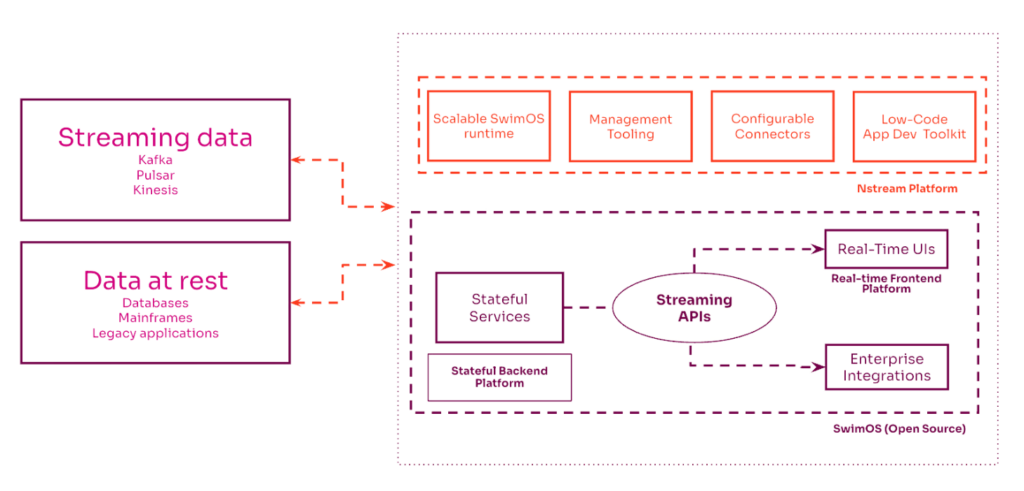Nstream Team
5 Sep 2023
How Nstream Helps You Build Streaming Data Applications in Minutes, Not Months
Enterprises today demand more value from their streaming data in less time. However, their existing architectures for streaming data applications make it virtually impossible to analyze and act on their data at scale and in real-time without compounding latency and cost.
Nstream delivers the time-to-value acceleration and tangible outcomes that businesses are looking for. More specifically, the Nstream Platform — the industry’s first full-stack streaming data application development platform built on SwimOS, a distributed operating system open-sourced in 2019 — allows enterprises to quickly build streaming data applications to get more value out of their streaming data pipelines.
In a time when developers are constantly under pressure to design software faster and minimize lead time to business impact, Nstream gives teams the ability to develop streaming data applications in minutes, not months. Here’s why speed is so important and how Nstream enables a 10-times faster time-to-value compared to traditional approaches.
How does Nstream accelerate streaming data application development?
Nstream significantly reduces the need for multiple data systems — and associated connectors and upgrade cycles — in the streaming data application development stack. In fact, designing, building, testing, and maintaining applications with Nstream takes four times fewer engineering hours compared to alternate approaches. This allows developers to rapidly build and deploy streaming data applications that make real-time visibility, insights, and decision automation a functional reality for all departments across the business.
With traditional streaming data application architectures, several data systems are required to ingest, store, persist, process, analyze, and visualize data for real-time use. Common systems include:
- Stream processing frameworks such as Pinot and Presto.
- Additional databases such as Druid, Clickhouse, and MongoDB.
- Additional applications servers such as Spring, NodeJS, and .NET.
- User interface frameworks such as Angular and React.
Development teams looking to design and implement streaming data applications often don’t have a deep understanding of these underlying streaming technologies and how they work. As a result, businesses have to either pay a software vendor for each data system or hire Subject Matter Experts (SMEs) to help with deployment and ongoing upkeep.
Powered by the industry’s first open-source, full-stack streaming data application development platform, Nstream allows developers to focus on building applications in a familiar way. Teams can use Nstream to create highly efficient applications that:
- Take data from streaming data sources (e.g., Kafka, Pulsar, Kinesis, etc.) and contextualize it with data at rest (e.g., databases, mainframes, legacy applications).
- Turn the context-enriched data into real-time stateful entities that continuously evaluate business logic and instantly act on relevant insights (e.g., an opportunity to enhance the customer experience, remedy an operational issue, or proactively investigate an anomaly).

Instead of learning the intricacies of multiple streaming data technologies and stateful programming techniques, developers can leverage Nstream’s low-code application templates for use cases such as customer 360, fraud detection, real-time visibility, and more. Template-based applications are deployed in a single click and then further customized depending on the details of the use case.
Nstream fulfills a transportation software company’s need for speed at scale
The need: Cubic│Trafficware, a top innovator in transportation and infrastructure, wanted a way to extend its offerings to deliver superior, highly accurate data for city intersections and traffic locations — within sub-second time frames.
Due to resource, scalability, and latency constraints, the company initially thought it was “impossible to build a real-time data service for continuous intelligence at scale with modern software infrastructure.” After all, the scale of the proposed project was massive, with the potential to include data from over 270 million vehicles and 300,000 traffic intersections.
The solution:
| After discovering Nstream, Cubic│Trafficware unlocked the ability to quickly build full-stack streaming data applications that provide the business with complete situational awareness and decision support in real-time. In Cubic | Trafficware’s case, this involves daily ingestion and transformation of petabytes of raw traffic data from connected infrastructure (traffic signals and other sensors). |
With Nstream, Cubic│Trafficware continues to broaden its deployment of streaming data applications nationally as part of its innovative solutions for intelligent infrastructure.
“The speed at which we capture and report traffic/intersection data is incredibly valuable to cities and counties, so it is gratifying to see it expand so rapidly,” said Joe Custer, GM of Cubic│Trafficware.
Build streaming data applications in minutes, not months
Nstream is hands down the fastest way to build streaming data applications that unlock the full potential of your business’s streaming data. Whereas other solutions require significant resources and streaming data expertise, Nstream allows teams to focus on designing and executing against a use case that will provide tangible business value both near and long term.
To learn how Nstream delivers tangible cost savings in addition to time savings, read How Nstream Lowers TCO by 70%. If you’re ready to get started, visit our Tutorials/Demo page on SwimOS.